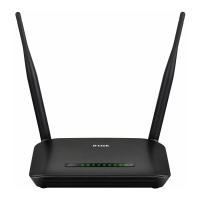
Do you have a question about the D-Link DSL-2740M and is the answer not in the manual?
| RJ-11 ADSL port | 1 |
|---|---|
| RJ-45 Ethernet ports | 4 |
| Wireless Interface | IEEE 802.11n/g/b |
| Wireless Bandwidth Rate IEEE 802.11b | 11, 5.5, 2, and 1 Mbps |
|---|---|
| Wireless Bandwidth Rate IEEE 802.11g | 54, 48, 36, 24, 18, 12, 9, and 6 Mbps |
| Wireless Bandwidth Rate IEEE 802.11n 20 MHz | 150, 130, 117, 104, 78, 52, 39, 26, 13 Mbps |
| Wireless Bandwidth Rate IEEE 802.11n 40 MHz | 300, 270, 243, 216, 162, 108, 81, 54, 27 Mbps |
| Operating Humidity | 0% to 90% non-condensing |
|---|---|
| Non-Operating Humidity | 5% to 95% non-condensing |
| Operating Temperature | 0 to 40 °C (32 to 104 °F) |
| Non-Operating Temperature | -20 to 65 °C (-4 to 149 °F) |
| Input Voltage | 100~240 V AC (±20%), 50/60 Hz |
|---|---|
| Output Voltage | 12 V DC |
| Output Current | 0.5 A |
| Dimensions | 160 x 120 x 25 mm (6.30 x 4.72 x 0.98 inches) |
|---|---|
| Weight | 205 grams (7.2 ounces) |
Details about revisions and release dates of the manual.
Legal information regarding D-Link and other company trademarks.
Lists all items included in the product box.
Details the hardware and software needed to use the router.
Provides an overview of the DSL-2740M Wireless N300 ADSL2+ Modem Router's features and capabilities.
Highlights the key functionalities and benefits of the DSL-2740M router.
Details the physical components and indicators of the DSL-2740M router.
Important steps and information to prepare before installing the DSL-2740M router.
Guidelines for optimizing wireless signal range and performance.
Step-by-step instructions for physically connecting the DSL-2740M router.
Guides users through the initial router setup process.
Allows advanced users to manually configure router settings.
Manual configuration steps for specific connection types like PPPoE, PPPoA, etc.
Configuration details for PPPoE and PPPoA internet connection types.
Configuration steps for setting up a dynamic IP address connection.
Configuration steps for setting up a static IP address connection.
Configuration steps for setting up the router in bridge mode.
Final step of the setup wizard to apply settings and complete the configuration.
Detailed steps for manually configuring the router's settings.
Overview of the web interface structure and navigation.
Access to basic configuration settings for the DSL-2740M.
Manual configuration options for ADSL internet connections.
Further configuration options for PPPoE/PPPoA, including DHCP PD and MLD Proxy.
Configuration of virtual circuits, service categories, and cell rates.
Configuration settings for Dual Stack Lite (DS-Lite) for IPv6 support.
Guides for configuring the router's wireless network settings.
Step-by-step wizard for easy wireless network configuration.
Detailed security settings for WPA-Personal encryption.
Configuration settings for WEP wireless security.
Configuration of local area network settings, including IP address and DHCP.
Configuration for IPv6 connectivity, including 6rd tunnel settings.
Configuration of system time, date, and daylight saving settings.
Access to advanced configuration features of the DSL-2740M router.
Configuration to open specific ports for network applications.
Configuration for Quality of Service to prioritize network traffic.
Configuration of firewall rules and Demilitarized Zone (DMZ) settings.
Configuration of DNS and Dynamic DNS settings.
Advanced settings for ADSL connection modes and types.
Advanced configuration options for the wireless network.
Configuration and management of the Wi-Fi Protected Setup (WPS) feature.
Configuration of MAC address filtering for wireless client access control.
Advanced LAN settings for UPnP and IGMP configuration.
Configuration for remote management access to the router via the internet.
Procedure to change the default administrator password for network security.
Options to save, load, or restore router configuration settings.
Procedure to update the router's firmware for new features and security.
Tools to test network and internet connectivity.
View logs of router events and network activities.
Instructions for connecting devices using the Wi-Fi Protected Setup (WPS) button.
Steps to connect to a wireless network using Windows 10.
Steps to connect to a wireless network using Windows 8 with WPA/WPA2 security.
Steps to connect to a wireless network using Windows 7 with WPA/WPA2 security.
Troubleshooting steps for accessing the router's web interface.
Procedure to reset the router if the administrator password is forgotten.
Troubleshooting connection issues with specific websites or email services.
Explanation of wireless and Wi-Fi technology.
Benefits and reasons for choosing D-Link wireless products.
Explanation of how wireless networks transmit data.
Overview of common users and benefits of wireless technology.
Examples of where wireless networks are commonly deployed.
Practical advice for installing and optimizing wireless networks.
Description of Infrastructure and Ad-hoc wireless networking modes.
Steps to verify the computer's IP address and network configuration.
Instructions for manually assigning a static IP address to a computer.
Explanation of different wireless security levels like WPA2 and WPA.
Detailed explanation of the WPA wireless security standard.